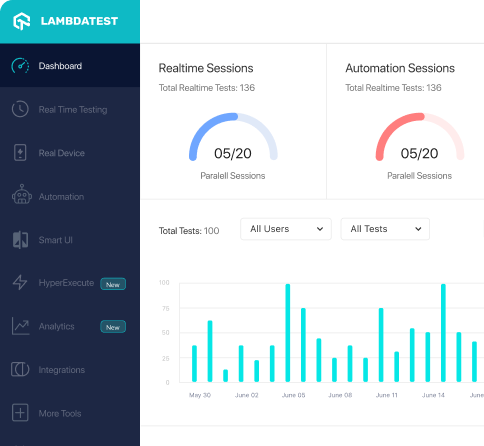How to use DeviceEventCallback class of com.testsigma.agent.mobile.ios package
Best Testsigma code snippet using com.testsigma.agent.mobile.ios.DeviceEventCallback
Source: DeviceEventCallback.java
...13import com.testsigma.agent.mobile.ios.libs.LibIMobileDevice;14import com.sun.jna.Pointer;15import lombok.extern.log4j.Log4j2;16@Log4j217public class DeviceEventCallback implements LibIMobileDevice.idevice_event_cb_t {18 private final IosDeviceListener iosDeviceListener;19 DeviceEventCallback(IosDeviceListener iosDeviceListener) {20 this.iosDeviceListener = iosDeviceListener;21 }22 @Override23 public void apply(LibIMobileDevice.IdeviceEvent iDeviceEvent, Pointer user_data) {24 try {25 int event = iDeviceEvent.event;26 String uuid = iDeviceEvent.uuid.getString(0);27 switch (event) {28 case 1:29 onDeviceAdded(uuid);30 break;31 case 2:32 onDeviceRemoved(uuid);33 break;...DeviceEventCallback
Using AI Code Generation
1import com.testsigma.agent.mobile.android.DeviceEventCallback;2import com.testsigma.agent.mobile.android.DeviceEvent;3import com.testsigma.agent.mobile.android.DeviceEventCallback;4import com.testsigma.agent.mobile.android.DeviceEvent;5public class DeviceEventCallback implements DeviceEventCallback {6 public void onEvent(DeviceEvent event) {7 String message = event.getMessage();8 System.out.println("Received Event: " + message);9 }10}11public class DeviceEventCallback implements DeviceEventCallback {12 public void onEvent(DeviceEvent event) {13 String message = event.getMessage();14 System.out.println("Received Event: " + message);15 }16}17public class DeviceEventCallback implements DeviceEventCallback {18 public void onEvent(DeviceEvent event) {19 String message = event.getMessage();20 System.out.println("Received Event: " + message);21 }22}23public class DeviceEventCallback implements DeviceEventCallback {24 public void onEvent(DeviceEvent event) {25 String message = event.getMessage();26 System.out.println("Received Event: " + message);27 }28}29public class DeviceEventCallback implements DeviceEventCallback {30 public void onEvent(DeviceEvent event) {31 String message = event.getMessage();32 System.out.println("Received Event: " + message);33 }34}35public class DeviceEventCallback implements DeviceEventCallback {36 public void onEvent(DeviceEvent event) {37 String message = event.getMessage();38 System.out.println("Received Event: " + message);39 }40}41public class DeviceEventCallback implements DeviceEventCallback {42 public void onEvent(DeviceEvent event) {43 String message = event.getMessage();44 System.out.println("Received Event: " + message);45 }46}47public class DeviceEventCallback implements DeviceEventCallback {48 public void onEvent(DeviceEvent event) {49 String message = event.getMessage();50 System.out.println("Received Event: " + message);51 }52}53public class DeviceEventCallback implements DeviceEventCallback {54 public void onEvent(DeviceEvent event) {55 String message = event.getMessage();56 System.out.println("Received Event: " + message);57 }58}59public class DeviceEventCallback implements DeviceEventCallback {DeviceEventCallback
Using AI Code Generation
1package com.testsigma.agent.mobile.ios;2import com.testsigma.agent.core.AbstractDeviceEventCallback;3import com.testsigma.agent.core.DeviceEvent;4import com.testsigma.agent.core.DeviceEventCallback;5import com.testsigma.agent.core.DeviceEventCallbackFactory;6import com.testsigma.agent.core.DeviceEventCallbackType;7import com.testsigma.agent.core.DeviceEventCallbackType.DeviceEventType;8import com.testsigma.agent.core.DeviceEventCallbackType.DeviceEventType.DeviceEventSubType;9import com.testsigma.agent.core.DeviceEventCallbackType.DeviceEventType.DeviceEventSubType.DeviceEventSubSubType;10import com.testsigma.agent.core.DeviceEventCallbackType.DeviceEventType.DeviceEventSubType.DeviceEventSubSubType.DeviceEventSubSubSubType;11import com.testsigma.agent.core.DeviceEventCallbackType.DeviceEventType.DeviceEventSubType.DeviceEventSubSubType.DeviceEventSubSubSubType.DeviceEventSubSubSubSubType;12import com.testsigma.agent.core.DeviceEventCallbackType.DeviceEventType.DeviceEventSubType.DeviceEventSubSubType.DeviceEventSubSubSubType.DeviceEventSubSubSubSubType.DeviceEventSubSubSubSubSubType;13import com.testsigma.agent.core.DeviceEventCallbackType.DeviceEventType.DeviceEventSubType.DeviceEventSubSubType.DeviceEventSubSubSubType.DeviceEventSubSubSubSubType.DeviceEventSubSubSubSubSubType.DeviceEventSubSubSubSubSubSubType;14import com.testsigma.agent.core.DeviceEventCallbackType.DeviceEventType.DeviceEventSubType.DeviceEventSubSubType.DeviceEventSubSubSubType.DeviceEventSubSubSubSubType.DeviceEventSubSubSubSubSubType.DeviceEventSubSubSubSubSubSubType.DeviceEventSubSubSubSubSubSubSubType;15import com.testsigma.agent.core.DeviceEventCallbackType.DeviceEventType.DeviceEventSubType.DeviceEventSubSubType.DeviceEventSubSubSubType.DeviceEventSubSubSubSubType.DeviceEventSubSubSubSubSubType.DeviceEventSubSubSubSubSubSubType.DeviceEventSubSubSubSubSubSubSubType.DeviceEventSubSubSubSubSubSubSubSubType;16import com.testsigma.agent.core.DeviceEventCallbackType.DeviceEventType.DeviceEventSubType.DeviceEventSubSubType.DeviceEventSubSubSubType.DeviceEventSubSubSubSubType.DeviceEventSubSubSubSubSubType.DeviceEventSubSubSubSubSubSubType.DeviceEventSubSubSubSubSubSubSubSubType.DeviceEventSubSubSubSubSubSubSubSubSubType;17public class DeviceEventCallbackClass extends AbstractDeviceEventCallback {DeviceEventCallback
Using AI Code Generation
1DeviceEventCallback callback = new DeviceEventCallback();2callback.setDeviceEventCallback(new DeviceEventCallback.DeviceEventCallbackListener() {3 public void onDeviceEvent(DeviceEventCallback.DeviceEvent deviceEvent) {4 if (deviceEvent == DeviceEventCallback.DeviceEvent.DEVICE_LOCKED) {5 }6 }7});8com.testsigma.agent.mobile.android.DeviceEventCallback callback = new com.testsigma.agent.mobile.android.DeviceEventCallback();9callback.setDeviceEventCallback(new com.testsigma.agent.mobile.android.DeviceEventCallback.DeviceEventCallbackListener() {10 public void onDeviceEvent(com.testsigma.agent.mobile.android.DeviceEventCallback.DeviceEvent deviceEvent) {11 if (deviceEvent == com.testsigma.agent.mobile.android.DeviceEventCallback.DeviceEvent.DEVICE_LOCKED) {12 }13 }14});15com.testsigma.agent.mobile.android.DeviceEventCallback callback = new com.testsigma.agent.mobile.android.DeviceEventCallback();16callback.setDeviceEventCallback(new com.testsigma.agent.mobile.android.DeviceEventCallback.DeviceEventCallbackListener() {17 public void onDeviceEvent(com.testsigma.agent.mobile.android.DeviceEventCallback.DeviceEvent deviceEvent) {18 if (deviceEvent == com.testsigma.agent.mobile.android.DeviceEventCallback.DeviceEvent.DEVICE_LOCKED) {19 }20 }21});22DeviceEventCallback callback = new DeviceEventCallback();23callback.setDeviceEventCallback(new DeviceEventCallback.DeviceEventCallbackListener() {24 public void onDeviceEvent(DeviceEventCallback.DeviceEvent deviceEvent) {25 if (deviceEvent == DeviceEventCallback.DeviceEvent.DEVICE_LOCKED) {26 }27 }28});29com.testsigma.agent.mobile.android.DeviceEventCallback callback = new com.testsigma.agent.mobile.android.DeviceEventCallback();30callback.setDeviceEventCallback(new com.testsigma.agent.mobile.android.DeviceEventCallback.DeviceEventCallbackListener() {31 public void onDeviceEvent(com.testsigma.agent.mobile.android.DeviceEventCallback.DeviceEvent deviceEvent) {32 if (deviceEvent == com.testsigma.agent.mobile.android.DeviceEventCallback.DeviceEvent.DEVICE_LOCKED) {33 }34 }35});DeviceEventCallback
Using AI Code Generation
1DeviceEventCallback callback = new DeviceEventCallback();2callback.setDeviceEventCallback(new DeviceEventCallback.DeviceEventCallbackListener() {3 public void onEvent(DeviceEventCallback.DeviceEvent deviceEvent) {4 }5});6DeviceEventCallback callback = new DeviceEventCallback();7callback.setDeviceEventCallback(new DeviceEventCallback.DeviceEventCallbackListener() {8 public void onEvent(DeviceEventCallback.DeviceEvent deviceEvent) {9 }10});11DeviceEventCallback callback = new DeviceEventCallback();12callback.setDeviceEventCallback(new DeviceEventCallback.DeviceEventCallbackListener() {13 public void onEvent(DeviceEventCallback.DeviceEvent deviceEvent) {14 }15});DeviceEventCallback
Using AI Code Generation
1DeviceEventCallback callback = new DeviceEventCallback();2callback.register();3callback.unregister();4public void onDeviceEvent(DeviceEvent event) {5 System.out.println(event);6}7public class DeviceEvent {8 private String deviceName;9 private String deviceUDID;10 private String eventName;11 private String eventValue;12 private String eventTimestamp;13 private String eventSource;14 public String getDeviceName() {15 return deviceName;16 }17 public void setDeviceName(String deviceName) {18 this.deviceName = deviceName;19 }20 public String getDeviceUDID() {21 return deviceUDID;22 }23 public void setDeviceUDID(String deviceUDID) {24 this.deviceUDID = deviceUDID;25 }26 public String getEventName() {27 return eventName;28 }29 public void setEventName(String eventName) {30 this.eventName = eventName;31 }32 public String getEventValue() {33 return eventValue;34 }35 public void setEventValue(String eventValue) {36 this.eventValue = eventValue;37 }38 public String getEventTimestamp() {39 return eventTimestamp;40 }41 public void setEventTimestamp(String eventTimestamp) {42 this.eventTimestamp = eventTimestamp;43 }44 public String getEventSource() {45 return eventSource;46 }47 public void setEventSource(String eventSource) {48 this.eventSource = eventSource;49 }50 public String toString() {51 return "DeviceEvent{" +52 '}';53 }54}55Method Description getDeviceName() Returns the name of the device. getDeviceUDID() Returns the UDID of theBlogs
Check out the latest blogs from LambdaTest on this topic:
Sometimes, in our test code, we need to handle actions that apparently could not be done automatically. For example, some mouse actions such as context click, double click, drag and drop, mouse movements, and some special key down and key up actions. These specific actions could be crucial depending on the project context.
Agile project management is a great alternative to traditional methods, to address the customer’s needs and the delivery of business value from the beginning of the project. This blog describes the main benefits of Agile for both the customer and the business.
The web paradigm has changed considerably over the last few years. Web 2.0, a term coined way back in 1999, was one of the pivotal moments in the history of the Internet. UGC (User Generated Content), ease of use, and interoperability for the end-users were the key pillars of Web 2.0. Consumers who were only consuming content up till now started creating different forms of content (e.g., text, audio, video, etc.).
Web applications continue to evolve at an unbelievable pace, and the architecture surrounding web apps get more complicated all of the time. With the growth in complexity of the web application and the development process, web application testing also needs to keep pace with the ever-changing demands.
Automation Testing Tutorials
Learn to execute automation testing from scratch with LambdaTest Learning Hub. Right from setting up the prerequisites to run your first automation test, to following best practices and diving deeper into advanced test scenarios. LambdaTest Learning Hubs compile a list of step-by-step guides to help you be proficient with different test automation frameworks i.e. Selenium, Cypress, TestNG etc.
LambdaTest Learning Hubs:
- JUnit Tutorial
- TestNG Tutorial
- Webdriver Tutorial
- WebDriverIO Tutorial
- Protractor Tutorial
- Selenium 4 Tutorial
- Jenkins Tutorial
- NUnit Tutorial
- Jest Tutorial
- Playwright Tutorial
- Cypress Tutorial
- PyTest Tutorial
YouTube
You could also refer to video tutorials over LambdaTest YouTube channel to get step by step demonstration from industry experts.
Most used methods in DeviceEventCallback
Try LambdaTest Now !!
Get 100 minutes of automation test minutes FREE!!



